EBS connector concurrency programs in Jitterbit Design Studio
The EBS concurrency programs available within the Oracle EBS connector allow you to use existing Oracle EBS concurrent programs to access Oracle EBS data and functions. This allows Jitterbit to populate Oracle interface tables, execute concurrent programs, and retrieve status information about the execution. This activity can be used to inspect the integration repository for the schema of the interface tables for the selected concurrent program(s), as well as the parameters required to execute the concurrent program.
The concept and implementation of concurrent programs used here is specific to Oracle applications. You can learn more about implementing Oracle concurrent programs in Oracle EBS System Administrator's Guide - Defining Concurrent Programs and Requests.
Note
Before you can use EBS concurrency programs in a Jitterbit operation, you will need to have an EBS endpoint defined. For more information on creating an endpoint, see EBS connector endpoint.
This page describes how to use EBS concurrency programs in Jitterbit using a simplified example that first populates Oracle interface tables with new customer data via a JDBC database connection in Jitterbit, and then calls an EBS concurrency program to validate and apply the newly created data into Oracle base tables.
Important
These examples are used for demonstration purposes only and do not cover all options available in the product; please refer to Design Studio for more comprehensive documentation.
Populating Oracle interface tables
Before using an Oracle concurrent program in a Jitterbit operation, you should already have set up an operation that provides the data you want to access with your Oracle EBS instance. This is accomplished through the standard functionality provided by Jitterbit and is not part of the Oracle EBS Connector.
Note
If you are not already familiar with Jitterbit, see Get started or Design Studio for detailed information on how to use the product.
For example, the first operation below starts with a local CSV source, then transforms that data for insertion in an Oracle EBS database. This first operation essentially populates the interface tables in the Oracle database. The second operation, which runs a selected concurrency program to validate and apply this data to base tables, is part of the Oracle EBS Connector and will be covered in the other sections on this page.
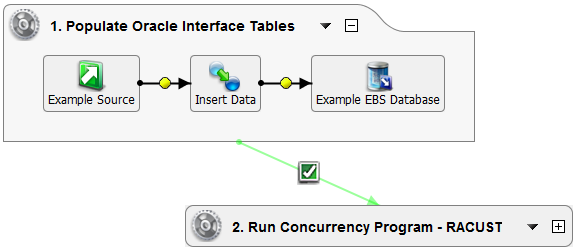
The procedure for setting up an operation that populates Oracle interface tables is not specific to the Oracle EBS Connector and can set up through a standard transformation. See Text to database wizard for detailed instructions related to this example. A variety of other Sources can also be used to supply the data for the operation.
In the example used here, the Oracle EBS database target is configured using the Oracle [JDBC] driver with the same credentials as used for the ebs connector endpoint. The configured EBS database target is set up for this example operation as follows:
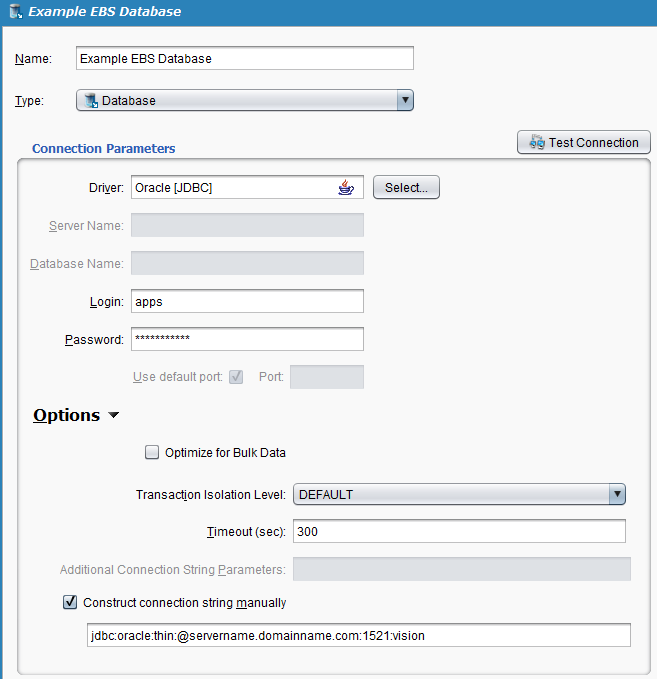
Creating an EBS concurrency program operation
In the same project where you have set up the operation that provides the data to the Oracle interface tables, you should create another operation that will run the concurrency program to validate and apply this data to Oracle base tables. The steps below walk through creating a new operation for the concurrency program, and after that operation is created, shows how to chain the concurrent program operation to run after the first operation has completed successfully.
-
Within your project within Jitterbit Studio, there are several ways to start a new EBS concurrency program. Each of the following options will start the EBS Concurrency Program Wizard to guide you through the process.
- Go to File > New > Connectors > New EBS Concurrency Program.
- In the tree on the left under Connectors, right-click on the Oracle EBS category, then select New EBS Concurrency Program.
- In the tree on the left under Connectors, double-click on the Oracle EBS category, then right-click on EBS Concurrency Programs and select New EBS Concurrency Program.
- In the top toolbar, click the connector icon (orange jigsaw piece)
 . In the popup, select Oracle EBS, then select EBS Concurrency Program.
. In the popup, select Oracle EBS, then select EBS Concurrency Program.
-
The Endpoint screen of the EBS Concurrency Program Wizard should open in the main view of Studio. This screen asks to select the endpoint that you would like to access data in. You should have already set up your endpoint in EBS connector endpoint. Use the dropdown to select the appropriate endpoint. Click Next when finished.

-
The Catalog screen of the EBS Concurrency Program Wizard presents a list of categories that contain specific concurrent programs available within your Oracle EBS instance. These are specific to EBS, and you will need to know under which category your desired concurrent program is located within the EBS catalog.
In this example, to create new customer data in the connected Oracle EBS instance, we will select the "Receivables" category. Then click Next to continue.
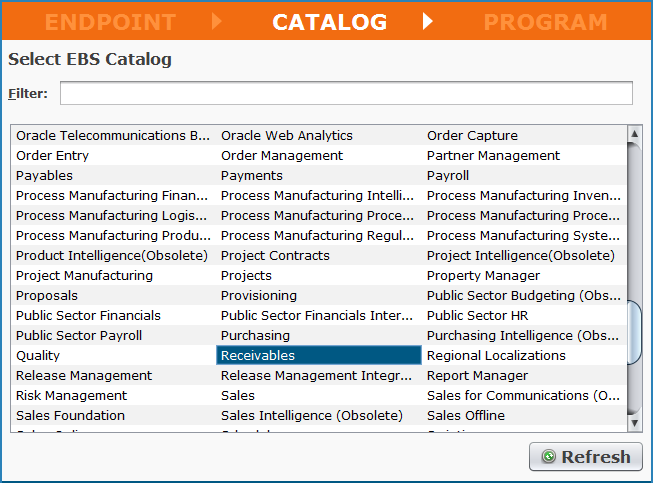
Note
During catalog and program selection, if you have a lot of items available in your EBS instance, you may need to wait a moment for them to load. You can also enter an item name into the Filter field. Try the Refresh button if the results are not what you expect.
-
The Program screen of the EBS Concurrency Program Wizard presents a list of the specific concurrent programs available within the selected category. These are specific to EBS, and you will need to know which concurrent program you want to use.
In this example, we will use the "RACUST" concurrent program. Click Finish to continue.
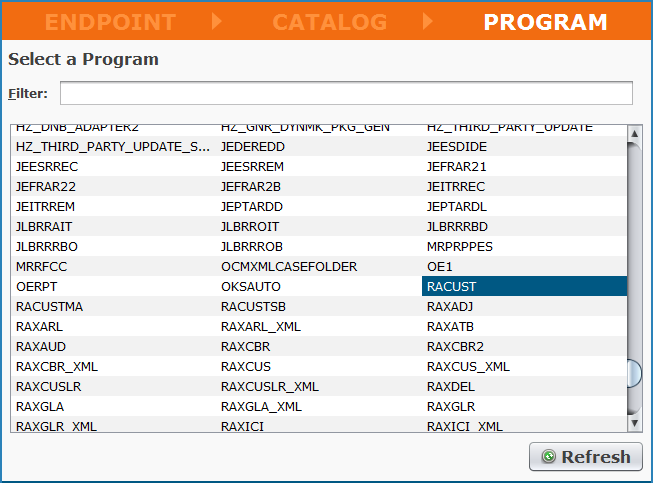
-
Jitterbit will then proceed with creating an EBS API request and response structure that will define the parameters within your concurrent program. A new tab should appear in Studio called EBS Concurrency Programs. You can rename your concurrency program here if desired. You can also use the + - buttons or arrows to expand all elements within each structure.
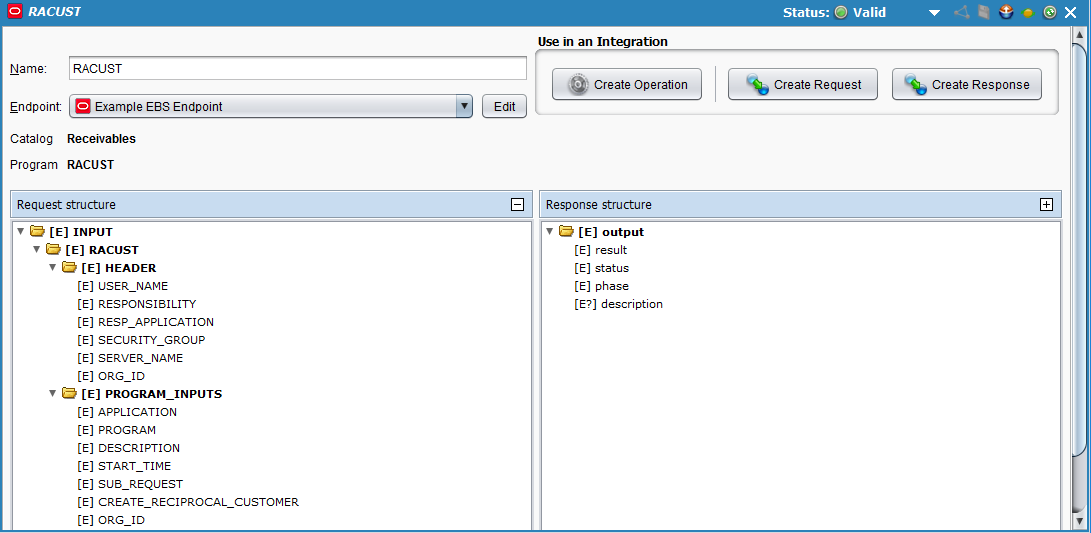
-
Next, on the same screen, click the button Create Operation located under Use in an Integration in the upper right corner. This will create the Jitterbit operation that will use your concurrency program in Oracle EBS.
-
A new tab should open in Studio called Operations, containing a graphical representation of the concurrency program within a Jitterbit operation. Save your operation by clicking either the single disk icon to save just this operation or the multiple disk icon to save all changes in your integration project. You should see the asterisk on the Operations tab and operation title disappear as your new concurrency program operation is now created and saved to your project.
-
If you have another operation that populates the Oracle interface tables, you can chain the two operations together at this time. To do so, right-click on the background of the first operation and select On Success > Operation > Select Existing, then select the existing operation you have just created. In this case this was our RACUST operation, which we have named "2. Run Concurrency Program - RACUST." The Operations tab should look similar to that below.
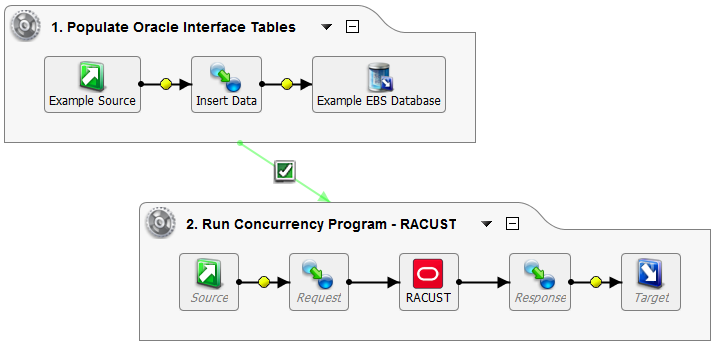
Note
The icons for Source, Request, Response, and Target in the image above are placeholders for the operation components, which we will define in the next section.
Defining the concurrency program operation components
Next we need to define the other components of the concurrency program operation, including Source, Request, Response, and Target.
You can either return to the graphical representation of the operation you have created and double-click each icon to configure each component, or you can create the Source, Request, Response, and Target separately and then drag and drop them from the tree on the left directly onto the icons in the visual representation of your operation.
Many different types of data can be used for each component of the operation. To learn more about additional customization options, refer to the Design Studio section of our documentation.
-
Source: For purposes of simplifying this example, the source will be hard-coded. Therefore we will remove the source by right-clicking on the source icon in the operation graph and selecting Remove From Graph.
Note
A variety of source types are available in Jitterbit. See Sources for more.
-
Target: Double-click on the Target icon. For purposes of simplifying this example, we will output the result, status, and phase of the operation to an XML file. Click the Create New Target button, give your target a Name (e.g. Example Target). For this example, we are using a private agent with local files enabled, and thus select a Type of "Local File" and Browse to a location on the private agent where we want to save the data. Enter a Folder and Filename you would like to save.
Note
You can also output to a variety of different target types. The type does not have to be the same as the source type. See Targets for options.
-
Request: Double-click on the Request icon and select Create New Transformation. This will open the Transformation Wizard which will walk you through creating the request.
Note
Additional information on request structures is provided under Transformations.
-
On the first screen, Name, provide a Name for your transformation or leave as the default. Then use the Source dropdown to select the source for the transformation. In the example our source is hard-coded so we will select "None." Click Finish to continue.
-
The Transformations tab should open where you can complete your mapping. Use the + to expand the source and target items in each tree. In a standard transformation, you would drag and drop each field you would like to be mapped from one tree to the other. For this example, to hard-code the source, double-click each field in the target side and type the following values into the script:
TARGET: EBS Concurrency Program: RACUST
INPUT > RACUST > HEADERScript USER_NAME <trans>"SERVICES"</trans>RESPONSIBILITY <trans>"QUICK_CUSTOMER"</trans>RESP_APPLICATION <trans>"AR"</trans>SECURITY_GROUP <trans>"STANDARD"</trans>SERVER_NAME <trans>""</trans>ORG_ID <trans>"204"</trans>TARGET: EBS Concurrency Program: RACUST
INPUT > RACUST > PROGRAM_INPUTSScript APPLICATION <trans>"AR"</trans>PROGRAM <trans>"RACUST"</trans>DESCRIPTION <trans>"INVENTORY"</trans>START_TIME <trans>""</trans>SUB_REQUEST <trans>""</trans>CREATE_RECIPROCAL_CUSTOMER <trans>"1"</trans>ORG_ID <trans>"204"</trans>After hard-coding the source, your transformation mapping should look similar to that shown below.
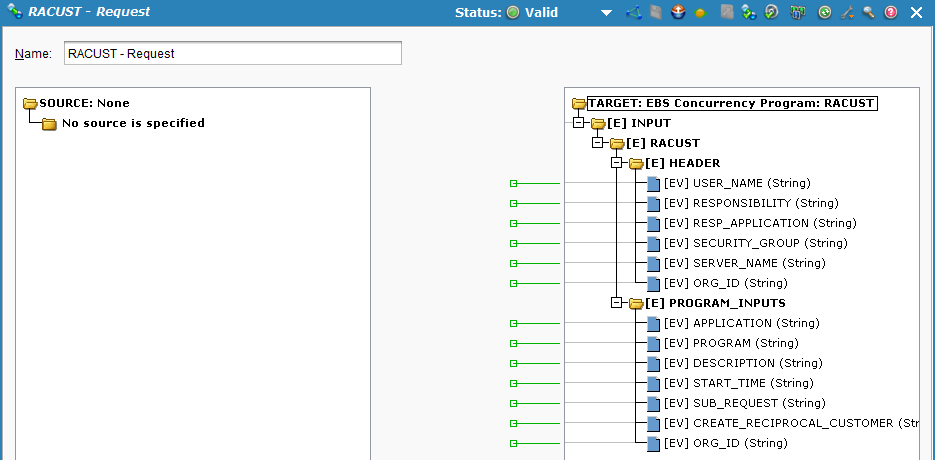
-
-
Response: Double-click on the Response icon and select Create New Transformation. This will open the Transformation Wizard which will walk you through creating the response.
Note
Additional information on response structures is provided under Transformations.
-
On the first screen, Name, provide a Name for your transformation or leave as the default. Then use the Target dropdown to select the target for the transformation. In the example we want to use the response from EBS, so we select "Oracle EBS Function Response." Click Next to continue.
-
On the next screen, Target, use the dropdown to select the concurrency program that you have already set up (e.g. "RACUST"). The lower portion of the screen will display the request and response structures associated with this program. Click Finish to continue.
-
The Transformations tab should open where you can complete your mapping. Use the + to expand the source and target sides. Click and drag the "OUTPUT" folder from the left side (source side) to the "OUTPUT" folder on the right side (target side). Your mapping screen should now look similar to that below.

-
The final operation setup should look similar to that below.
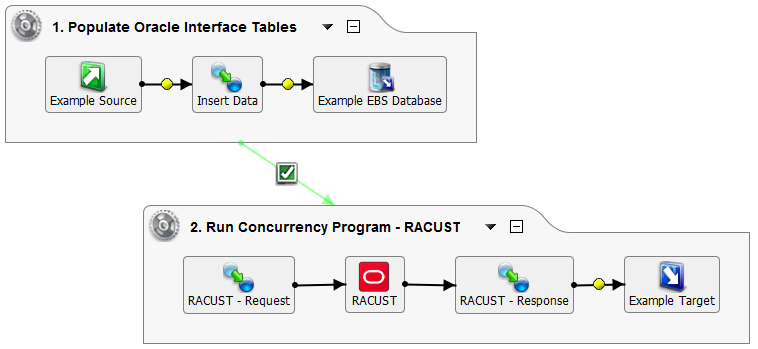
Deploying and executing the operations
With both the operation to insert data to the Oracle interface tables as well as the EBS concurrency program operation fully configured, we are ready to deploy and execute the operations.
- From the first operation within the Operations tab, click the deploy
 icon.
icon. - Then click the execute
 icon to place the operations in the queue for execution. The first operation will complete first, followed by the second operation that is chained to run if the first operation is successful.
icon to place the operations in the queue for execution. The first operation will complete first, followed by the second operation that is chained to run if the first operation is successful. - In the lower portion of the screen, the Operation monitor should indicate that your first operation was run successfully. If not, you can double-click the Status icon to view any log messages.
 If you want to check to make sure your second operation has run successfully as well, you can also right-click on Operations in the tree on the left and select Operation Log to view the logs for all operations in your project.
If you want to check to make sure your second operation has run successfully as well, you can also right-click on Operations in the tree on the left and select Operation Log to view the logs for all operations in your project. - You should also now see the output response that was mapped to your target file. In the example, the XML file is now created locally in the location you specified. Since the operation was run successfully, we see a result of "Success," status of "Normal," and phase of "Completed."